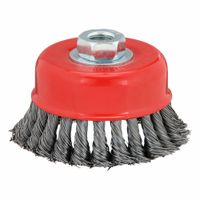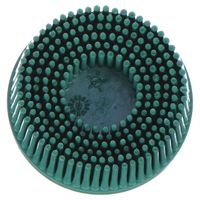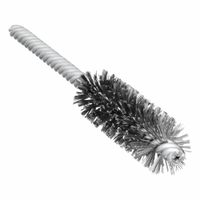Call +(254) 703 030 000 / 751 483 999 / 721 704 777
.....Read More
Frequently Asked Questions
What are abrasive brushes used for?
Please provide the question you would like me to answer.
How do you choose the right abrasive brush for a specific task?
Please specify what you would like me to elaborate on.
What materials are abrasive brushes made from?
Abrasive brushes are made from a variety of materials, with the primary components being the bristles and the abrasive grit. Bristle materials can include natural fibers like tampico (a plant fiber), synthetic fibers such as nylon, polypropylene, and ceramic, or metal wires like steel, stainless steel, brass, and bronze. The choice of bristle depends on the application, with natural fibers offering a softer touch and synthetic/metal bristles providing more aggressive action.
The abrasive grit is typically embedded within or attached to the bristles. Common abrasive materials include silicon carbide, aluminum oxide, ceramic, and diamond. Silicon carbide is known for its sharpness and is effective on a wide range of materials. Aluminum oxide is durable and widely used for general-purpose deburring and finishing. Ceramic abrasives offer extended life and cutting ability, particularly for tough applications. Diamond abrasives are used for extremely hard materials like ceramics and carbides due to their superior hardness. The grit size varies, with coarser grits for heavy material removal and finer grits for polishing and finishing. The combination of bristle material and abrasive grit is carefully selected to achieve specific finishing, deburring, or cleaning results on various surfaces.
How do you maintain and clean abrasive brushes?
Maintaining and cleaning abrasive brushes is crucial for their longevity and effective performance. After each use, remove any accumulated debris, such as dust, grit, or residue, from the bristles. A stiff-bristled brush or an air compressor can be effective for this. For wet applications, rinse the brushes thoroughly with water to remove any slurry or contaminants. Ensure the brushes are completely dry before storing them to prevent rust on metal components and mildew on natural fibers. Store them in a dry, well-ventilated area, ideally hanging them to maintain bristle shape. Periodically, a deeper clean may be necessary. For synthetic bristles, a mild soap and water solution can be used, followed by a thorough rinse. For natural bristles, specialized brush cleaning solutions are recommended. Avoid harsh chemicals or solvents that could damage the bristles or their bonding. Regular inspection for worn or damaged bristles is also important; replace brushes when significant wear is observed to maintain consistent performance and avoid surface damage.
What safety precautions should be taken when using abrasive brushes?
Please specify what you would like me to answer.
How do wire wheel brushes differ from cup brushes?
Wire wheel brushes and cup brushes are both abrasive tools used for surface preparation, but they differ in their design and typical applications.
Wire wheel brushes feature bristles radiating outwards from a central hub, forming a wheel shape. They are designed for general-purpose cleaning, deburring, rust removal, and paint stripping on flat or irregular surfaces. The wider contact area of a wheel brush makes it effective for covering larger areas quickly. They are commonly used with angle grinders, bench grinders, or drills.
Cup brushes, on the other hand, have bristles arranged in a cup-shaped housing. This design allows for more aggressive cleaning and surface conditioning, particularly in corners, edges, and confined spaces. The bristles in a cup brush often have a higher density, providing a more concentrated scrubbing action. They are typically used with angle grinders for heavy-duty tasks like concrete cleaning, weld preparation, and scale removal.
In summary, while both are wire brushes, wheel brushes excel in general-purpose surface cleaning over wider areas, and cup brushes are better suited for aggressive cleaning and precise work in tighter spaces.
What are the best practices for using end brushes in tight spaces?
When using end brushes in tight spaces, consider the following best practices: * Brush Material and Abrasive Type: Select a brush with bristles made from materials appropriate for the application. Steel wire is durable for aggressive cleaning, while brass or nylon bristles are softer for delicate surfaces. The abrasive type, if any, should also match the material being worked on to avoid damage.
* Brush Size and Shape: Choose the smallest brush size that can effectively reach the tight space without causing damage to surrounding areas. End brushes come in various shapes (e.g., straight, flared, cup), so pick one that allows for optimal contact and maneuverability.
* Tool Selection: Use a rotary tool with adjustable speed to control the aggressiveness of the brush. A flexible shaft attachment can also be beneficial for reaching awkward angles.
* Speed and Pressure: Operate the tool at a lower speed to prevent overheating, excessive material removal, or premature brush wear. Apply light, consistent pressure, allowing the brush to do the work rather than forcing it.
* Safety Precautions: Always wear appropriate personal protective equipment (PPE), including safety glasses, gloves, and a dust mask, as bristles can break off and debris can be generated. Ensure proper ventilation in the workspace.
* Direction of Rotation: Pay attention to the direction of the brush's rotation relative to the workpiece. Often, working with the tips of the bristles can be more effective for detail work in tight areas.
* Cleaning and Maintenance: Regularly clean the brush to remove debris and maintain its effectiveness. Inspect the bristles for wear or damage before each use and replace the brush if necessary.
How do you determine the grit size needed for a specific application?
Determining the appropriate grit size for a specific application depends on several factors, primarily the desired finish, the material being worked on, and the amount of material to be removed.
Finer grit sizes, typically above 220, are used for achieving a smooth, polished finish. They remove very little material and are ideal for final sanding stages, preparing surfaces for paint or stain, or creating a high-gloss look on softer materials like wood or plastics.
Coarser grit sizes, ranging from 40 to 100, are designed for aggressive material removal. They are used for tasks like shaping, stripping old finishes, or quickly smoothing rough surfaces. These grits leave noticeable scratches, requiring subsequent sanding with progressively finer grits to achieve a smooth finish.
Medium grits, from 100 to 220, serve as an intermediate step. They effectively remove scratches left by coarser grits and prepare the surface for finer sanding or initial finishing. They offer a balance between material removal and surface refinement.
The material itself also plays a crucial role. Harder materials like metal or stone often require coarser grits initially to abrade the surface, while softer materials like wood or drywall can start with medium grits for most tasks. Always test a small, inconspicuous area first to ensure the chosen grit produces the desired outcome without damaging the material.
What are the advantages of using nylon abrasive brushes?
Nylon abrasive brushes offer several advantages due to their unique construction and material properties. They are known for their durability and flexibility, allowing them to conform to irregular surfaces and provide consistent finishing. Unlike wire brushes, nylon bristles won't break off and embed in the workpiece, which is a significant safety and quality benefit, especially in applications like deburring or cleaning sensitive materials.
These brushes are also highly resistant to chemicals, corrosion, and moisture, making them suitable for wet applications and harsh environments. The synthetic nature of nylon allows for the incorporation of various abrasive grains, such as silicon carbide or aluminum oxide, directly into the bristles. This provides a uniform abrasive action throughout the life of the brush and ensures a consistent finish.
Furthermore, nylon abrasive brushes are non-sparking, which is crucial in environments where flammable materials are present. They generate less heat during operation compared to more aggressive abrasives, reducing the risk of workpiece distortion or discoloration. This makes them ideal for tasks requiring a gentler touch, such as light deburring, surface conditioning, cleaning, and blending. Their versatility in grit sizes and filament diameters allows for a wide range of applications, from aggressive material removal to fine polishing.
How do you properly store abrasive brushes to extend their lifespan?
To properly store abrasive brushes and extend their lifespan, consider the following:
Cleanliness: After each use, thoroughly clean brushes to remove debris, dust, and residues. This prevents material buildup that can harden and damage bristles or the brush's overall structure.
Drying: Ensure brushes are completely dry before storage. Moisture can lead to rust on metal components, rot in natural bristles, or degrade synthetic materials. Hang brushes to air dry, or use a clean cloth to wick away excess water.
Protection: Store brushes in a way that protects their bristles. For cup or wheel brushes, consider individual storage containers or dedicated racks that prevent bristles from being bent, crushed, or otherwise deformed. For hand brushes, a toolbox or drawer where they won't be jostled against other tools is ideal.
Environment: Store brushes in a cool, dry environment, away from direct sunlight, extreme temperatures, and high humidity. These conditions can cause bristles to become brittle, warp, or degrade more quickly.
Organization: Organize brushes by type or size to prevent them from tangling or damaging each other. A well-organized storage system also makes it easier to find the right brush for the job, reducing wear and tear from improper handling.






